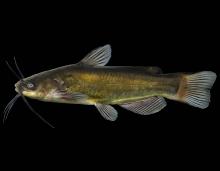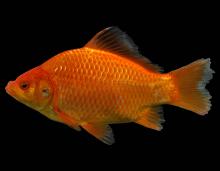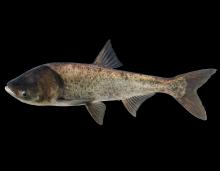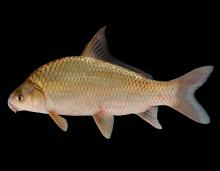Fishes
Media

Species Types
Scientific Name
Pylodictis olivaris
Description
The flathead catfish has a broad, flattened head with small eyes on top. The lower jaw projects beyond the upper jaw. It occurs in most of the large streams of Missouri, preferring places with a slow current.
Media

Species Types
Scientific Name
Ameiurus melas
Description
The black bullhead is widespread in Missouri. It is the most common bullhead catfish in north and west portions of the state. It has dusky or black chin barbels, and the edge of its tail fin is notched, not straight.
Media

Species Types
Scientific Name
Esox americanus vermiculatus
Description
The grass pickerel is the most common and widely distributed pike in Missouri. It is also the smallest, seldom exceeding 10 or 12 inches in length.
Media

Species Types
Scientific Name
Esox lucius
Description
The largest pike native to Missouri, the northern pike can be more than 4 feet long and weigh more than 40 pounds. Missouri is on the southern edge of the range of this species. Because of its rarity here, it is of little importance as a game fish.
Media

Species Types
Scientific Name
Carassius auratus
Description
Goldfish are not native to North America. They often escape into the wild from bait buckets and other causes, but there are few self-sustaining populations in Missouri.
Media

Species Types
Scientific Name
Ctenopharyngodon idella
Description
Grass carp are large-bodied with a broad head and a terminal transverse mouth. The scales appear crosshatched. A native of east Asia, it is now widely distributed in the Missouri, Mississippi, and St. Francis rivers and in impoundments.
Media

Species Types
Scientific Name
Mylopharyngodon piceus
Description
The black carp is a large, invasive carp from Asia. It eats mussels and snails and can damage populations of native mollusks. It is illegal to transport live black carp across state lines.
Media

Species Types
Scientific Name
Hypophthalmichthys nobilis
Description
The bighead carp is an invasive Asian carp. It does not jump as frequently as its cousin the silver carp, but it also leaps from the water when disturbed, threatening boaters' safety.
Media

Species Types
Scientific Name
Hypophthalmichthys molitrix
Description
The silver carp is an invasive, nonnative fish. It is illegal to use it as live bait. Do not collect, transport, or dump it. It's related to the bighead carp, but its head is smaller and the eyes higher. The keel extends up to the base of the pectoral fins.
Media

Species Types
Scientific Name
Carpiodes carpio
Description
The river carpsucker has a silvery, deep, rather thick body, a long, sickle-shaped dorsal fin, and whitish lower fins. It is the most abundant and widely distributed carpsucker in Missouri.
See Also


Media

Species Types
Scientific Name
Amphiuma tridactylum
Description
The three-toed amphiuma is an eel-like, completely aquatic salamander. It has very small forelimbs and hind limbs, each with three tiny toes. In Missouri it’s found only in the Bootheel region.
Media

Species Types
Scientific Name
Siren intermedia nettingi
Description
The western lesser siren is an eel-like, aquatic salamander with external gills, small eyes, small forelimbs with four toes, and no hind limbs. In Missouri, it’s found mostly in the Bootheel and northward in counties near the Mississippi River.
About Fishes in Missouri
Missouri has more than 200 kinds of fish, more than are found in most neighboring states. Fishes live in water, breathe with gills, and have fins instead of legs. Most are covered with scales. Most fish in Missouri “look” like fish and could never be confused with anything else. True, lampreys and eels have snakelike bodies — but they also have fins and smooth, slimy skin, which snakes do not.





















